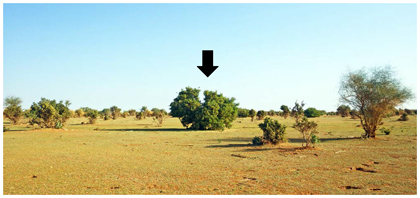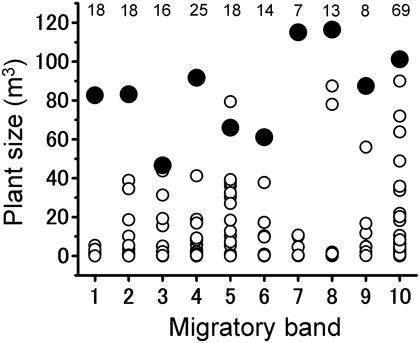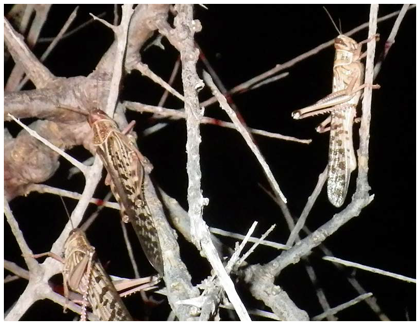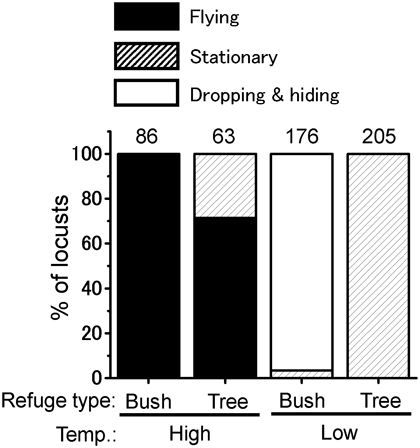Spatiotemporal distribution patterns of the desert locust in Africa
Description
The desert locust, Schistocerca gregaria, is one of the most destructive pests in the world. Sometimes, desert locust populations grow explosively, forming swarms and causing locust plagues. A plague can affect up to 20% of the earth’s surface across Africa, the Middle East, and Southwest Asia. Desert locusts can potentially damage the livelihoods of a tenth of the world's population. The preventive approach involves monitoring and spraying of locust breeding areas. However, this is difficult in practice as many of the principal breeding zones are in remote areas and difficult to reach. Despite these constraints, we will keep studying the locust and aim for efficient and sustainable control measures with due consideration to environmental well-being. We have learned, for example, that gregarious locusts can form a dense group at certain sites within a day. If we can understand these spatiotemporal aggregation patterns, we can control locusts efficiently using only small amounts of pesticides. To obtain these ecological data, we have conducted field surveys in Mauritania in collaboration with the Mauritanian National Anti-Locust Center.
In the field, actively marching migratory bands of gregarious nymphs passed some plants before finally roosting and aggregating on patchily distributed trees around dusk (Fig. 1). Migratory bands formed the largest group on the largest tree within the local plant community (Fig. 2). They apparently chose the largest plants. Adults similarly roosted on large trees or medium-sized bushes (Fig. 3). Flight escape was the preferred defense when temperatures were above the minimum threshold for locust flight (22 °C) (Fig. 4). At low temperatures, defense response to predator threat varied with plant size and locust height off the ground: locusts in low bushes dropped to the center of the bush and hid, whereas those above 2 m in trees remained stationary. These alternative defense behaviors appear to be adaptive under the different environmental conditions. Flight escape is extremely effective but cannot be performed under 22 °C. Hence, alternative defenses (dropping or remaining stationary) are necessary. These defenses are effective at low temperatures because dynamic locomotion is not required.
Our results suggest that desert locusts integrate information about microhabitat, temperature, and threat characteristics to adaptively adjust defense tactics. Control operation and monitoring should consider these ecological characteristics especially because this plant-size-dependent roosting site choice during the night may contribute to the development of artificial trapping systems for locusts and a shift to a new environment-friendly, night control approach.
Figure, table
-
Fig. 1. Night-roosting site choice by gregarious nymphs of Schistocerca gregaria.
Arrow indicates the largest tree roosted on by the largest locust group. -
Fig. 2. Plant-size distribution at each site where 10 migratory bands of Schistocerca gregaria roosted.
Closed circles indicate the plants roosted on by the largest locust group (the center) and open circles indicate other individual plants in the local site (within 20 m from the center). The largest aggregation formed on the largest tree within the plant community in nine of the ten bands. Figures at the top indicate the numbers of plants examined. -
Fig. 3. Adult locusts roosting on the branches of a large tree during the night.
-
Fig. 4. Defensive responses exhibited by adults including flying, stationary, and dropping and hiding by using plants as a refuge.
Adults perched on small bushes (< 1.5 m height) or large trees (> 2 m height) in the morning (07:30–08:30) when the ambient temperature was either higher or lower than their critical body temperature for flight (22 °C). Figures at the top indicate sample sizes.
- Affiliation
-
Japan International Research Center for Agricultural Sciences Crop, Livestock and Environment Division
- Research project
- Program name
- Term of research
-
FY2018(FY2016-FY2020)
- Responsible researcher
-
Maeno Kotaro ( Crop, Livestock and Environment Division )
Ould Mohamed Sid'Ahmed ( Centre National de Lutte Antiacridienne )
- ほか
- Publication, etc.
-
https://doi.org/10.3390/insects9030099
Maeno KO and Ould Baba Ebbe MA (2018) Insects, 9(3):1-13
https://doi.org/10.1016/j.jaridenv.2018.07.005Maeno KO et al. (2018) Journal of Arid Environments, 158:47-50
- Japanese PDF
-
A4362.68 KB
A3255.09 KB
- English PDF
-
A4562.78 KB
A3424.44 KB
- Poster PDF
-
2018_B07_poster.pdf298.54 KB




